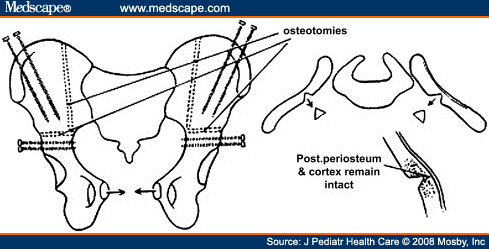Bladder exstrophy is a rare birth condition where the abdominal all and pelvis fail to completely fuse, leaving a child with a variety of congenital abnormalities that can include an incompletely formed pelvis, bladder and genitals. Bladder exstrophy affects between one in 10-50,000 children; an even rarer form known as cloacal exstrophy includes an incomplete formation of the intestine and affects one in 400,000 live births.
 |
| Drs. John P Gearhart, MD and Heather DiCarlo, MD. |
The MRI-guided system uses technology typically used by neurosurgeons and orthopedists for complex brain and spinal surgeries. The Federal Drug Administration and Institutional Review Board of Johns Hopkins recently approved the MRI-based system for use in children with exstrophy. The day prior to a planned exstrophy closure, the child undergoes a pelvic MRI. Images from the pelvic MRI are reviewed by Dr. DiCarlo and Aylin Tekes, MD, a pediatric radiologist at Johns Hopkins. Important anatomic structures, including the bony landmarks of the pelvis (the anterior superior iliac spine and pelvic tubercles) and soft tissue landmarks (like the umbilicus and anus), are identified and marked using the MRI-guided technology. The following day in the operating room, DiCarlo is able to "register" (or align) the MRI images with a real-time pointer using a strap that is temporarily placed on the child's chest – where it remains stable during the surgery. Using the pointer, DiCarlo can then correlate the patient's surgical anatomy with the MRI images – allowing her to identify and preserve important structures and observe how changes in the pelvic anatomy during surgery can affect correlated structures on MRI. Dr. Paul Sponseller, MD, a pediatric orthopedic surgeon, can then realign and "fix" the pelvis, correcting the bony abnormalities associated with the disease.
 |
| From http://www.medscape.com/viewarticle/583538_3 |
A secure closure of the bladder and pelvis is the crucial step in the operation and it involves identification, dissection and preservation of the pelvic floor muscles. Dr. DiCarlo explains,
"When we're operating we are able to see those muscles, and we know we're getting those fibers completely dissected."To date, the MRI-guided system has been used on 10 boys and girls undergoing bladder exstrophy closure or reclosure. All have done well without adverse events and DiCarlo and the multidisciplinary exstrophy team continue to learn from the technology. It is their hope that the MRI-guided system may help in other complex surgeries like the repair of cloacal exstrophy or epispadias.
The story was extracted from "A Novel Approach to Bladder Exstrophy Closure Yields Insights" in Johns Hopkins Urology: News for Physicians, Winter 2015 by Johns Hopkins Medicine.
I wanted to say that I have loved this blog.Very informative post with lots of information included in the posting.
ReplyDeleteYou have made some really good points here ! You might also be interested to know more about generating more leads and getting the right intelligence to engage prospects.E-Health Care Lists implements new lead gen ideas and strategies for generating more leads and targeting the right leads and accounts.E-Health Care Lists is one of the global suppliers of healthcare mailing list & email list.Marketing to the healthcare industry, reaching the doctors and other healthcare decision makers is often an impossibletask.Please refer to
Chief of Urology Mailing list & Email list
I was diagnosed as HEPATITIS B carrier in 2013 with fibrosis of the
ReplyDeleteliver already present. I started on antiviral medications which
reduced the viral load initially. After a couple of years the virus
became resistant. I started on HEPATITIS B Herbal treatment from
ULTIMATE LIFE CLINIC (www.ultimatelifeclinic.com) in March, 2020. Their
treatment totally reversed the virus. I did another blood test after
the 6 months long treatment and tested negative to the virus. Amazing
treatment! This treatment is a breakthrough for all HBV carriers.